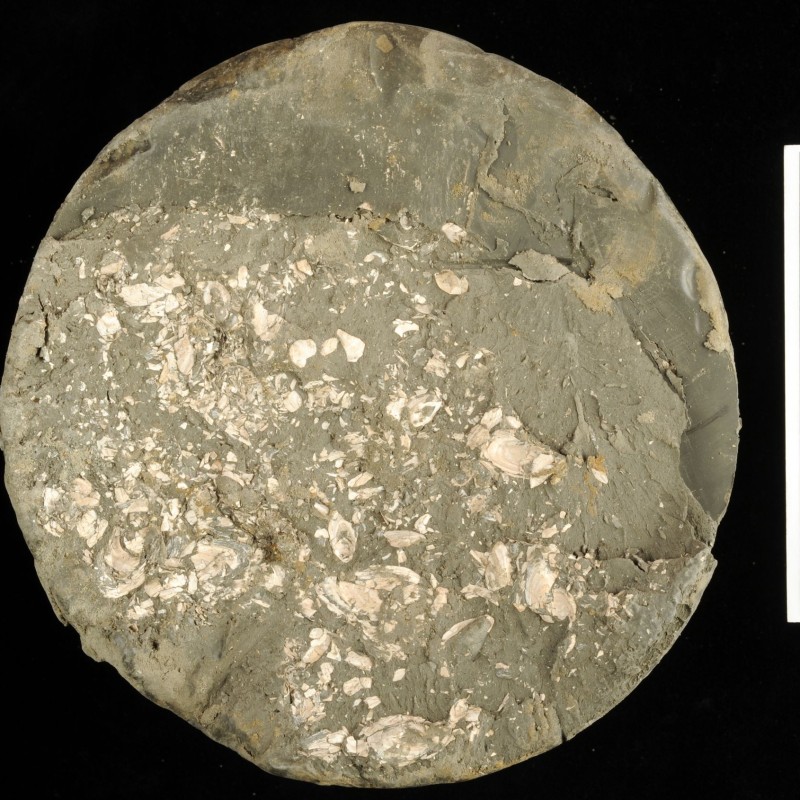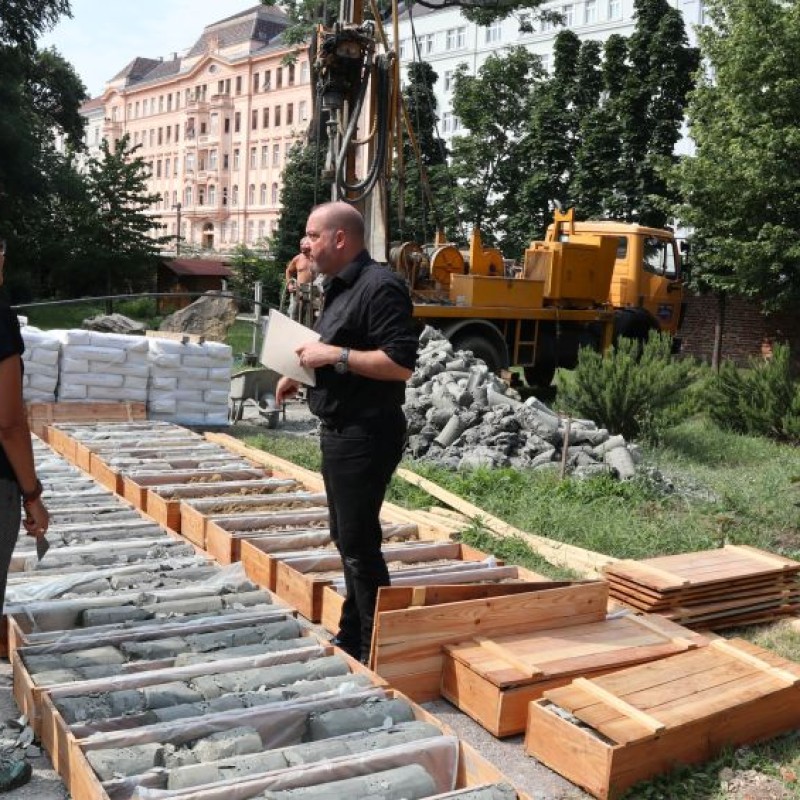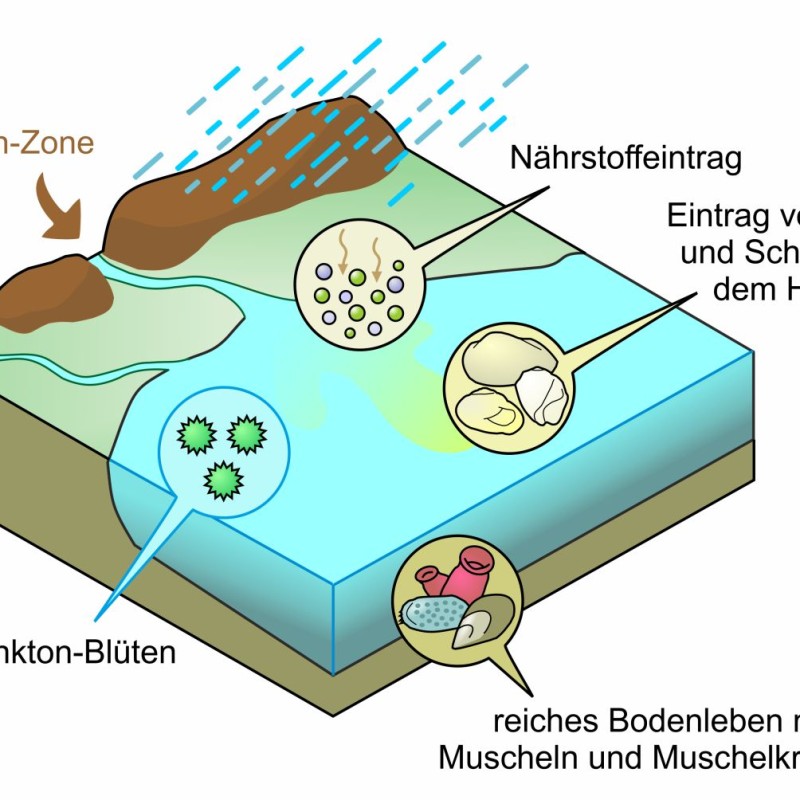Discovered underground: the Paleo-Wien and the Paleo-Liesing rivers in Vienna’s 3rd District
05. December 2022
In the course of drilling an 80-metre-deep well in the garden of the Federal Geological Institute in Vienna's 3rd district
(Landstraße), the deposits of two rivers were discovered in a clay layer of the Vienna Basin: the Paleo-Wien and the Paleo-Liesing.
The analysis of drill core samples furnishes new insights into the era of Lake Pannon 10.4 million years ago.
In
the garden of the Federal Geological Survey (Neulinggasse 38, 1030 Vienna), a 80-m-deep well was drilled for geothermal and
geophysical testing. Scientific analysis of the drill core provides insights also into Vienna’s geological history: it was
in this place, 10.4 million years ago, that the Paleo-Wien and Paleo-Liesing rivers flowed into Lake Pannon, which extended
from today's Alpine foothills near Vienna to Belgrade via Budapest.
Between 11.6 and 9 million years ago, Vienna and the Vienna Basin were situated on the eastern edge of Lake Pannon. “10.4 million years ago, at half the size of today's Black Sea, Lake Pannon was the largest lake in Europe. Vienna lay on its western shore. As yet, however, very little was known about its Alpine tributaries,” says Univ. Prof. Dr. Mathias Harzhauser, head of the NHM Vienna’s Geological-Palaeontological Department. Blue-grey in colour, fine-grained and rich in clay, the deposits of the lake constitute the groundwater aquiclude (impermeable clay layer in the subsoil) in large areas of the city. In the 19th and early 20th centuries, the clay deposits were mined in numerous clay pits for the production of bricks.
Close-meshed sampling and a multidisciplinary analysis of the drill core at the Federal Geological Survey have now unearthed new information on the era of Lake Pannon. Analyses of the clay mineralogy permitted conclusions about the climate and the sediment input from the hinterland in the west, about eight kilometres away, the present-day Vienna Woods with the flysch zone (alternating layers of sandstone and marl) and the Northern Calcareous Alps (limestones and dolomites).
Under the supervision of Univ. Prof. Dr. Mathias Harzhauser (NHM Vienna), Dr. Mandana Peresson and DDipl.Ing. Christian Benold from the Geological Survey (GBA) evaluated the investigations into clay mineralogy and geochemistry. Dr. Stjepan Ćorić (GBA) worked on nannofossils, Dr. Oleg Mandic (NHM Vienna) examined microfossils. Prof. Dr. Gert J. De Lange from Utrecht (Netherlands) provided assistance for the interpretation of geochemical parameters.
“The mineralogical analysis clearly shows the influence of the hinterland; we can clearly distinguish between sediment inputs from the Paleo-Liesing and the Paleo-Wien,” notes Dr Mandana Peresson from the Department of Mineral Geology at the Federal Geological Survey.
Tracing the Paleo-Wien and the Paleo-Liesing
Redeposited nannofossils (smaller than three hundredths of a millimetre) from the flysch zone dominate in the upper part of the core and allow comparisons to be drawn with a river similar to today's Wien river, which originates in the flysch zone. A coarser horizon (extended clay or rock layer) at a depth of 30.7 metres can also be clearly assigned to the flysch zone.
At a depth of 32.5 m, a section with 10 times higher carbonate values and gravel is interpreted to be the result of drainage from the Northern Calcareous Alps and is thus considered to be part of the Paleo-Liesing. Individual fossil horizons also demonstrate freshwater input from the hinterland.
Published in the journal Palaeogeography, Palaeoclimatology, Palaeoecology the results of the study are freely accessible:
Harzhauser, M., Peresson, M., Benold, C., Mandic, O., Ćorić, S. & De Lange, G.J. (2022): Environmental shifts in and around Lake Pannon during the Tortonian Thermal Maximum based on a multi-proxy record from the Vienna Basin (Austria, Late Miocene, Tortonian). - Palaeogeography, Palaeoclimatology, Palaeoecology, 610, 111332. https://doi.org/10.1016/j.palaeo.2022.111332
Between 11.6 and 9 million years ago, Vienna and the Vienna Basin were situated on the eastern edge of Lake Pannon. “10.4 million years ago, at half the size of today's Black Sea, Lake Pannon was the largest lake in Europe. Vienna lay on its western shore. As yet, however, very little was known about its Alpine tributaries,” says Univ. Prof. Dr. Mathias Harzhauser, head of the NHM Vienna’s Geological-Palaeontological Department. Blue-grey in colour, fine-grained and rich in clay, the deposits of the lake constitute the groundwater aquiclude (impermeable clay layer in the subsoil) in large areas of the city. In the 19th and early 20th centuries, the clay deposits were mined in numerous clay pits for the production of bricks.
Close-meshed sampling and a multidisciplinary analysis of the drill core at the Federal Geological Survey have now unearthed new information on the era of Lake Pannon. Analyses of the clay mineralogy permitted conclusions about the climate and the sediment input from the hinterland in the west, about eight kilometres away, the present-day Vienna Woods with the flysch zone (alternating layers of sandstone and marl) and the Northern Calcareous Alps (limestones and dolomites).
Under the supervision of Univ. Prof. Dr. Mathias Harzhauser (NHM Vienna), Dr. Mandana Peresson and DDipl.Ing. Christian Benold from the Geological Survey (GBA) evaluated the investigations into clay mineralogy and geochemistry. Dr. Stjepan Ćorić (GBA) worked on nannofossils, Dr. Oleg Mandic (NHM Vienna) examined microfossils. Prof. Dr. Gert J. De Lange from Utrecht (Netherlands) provided assistance for the interpretation of geochemical parameters.
“The mineralogical analysis clearly shows the influence of the hinterland; we can clearly distinguish between sediment inputs from the Paleo-Liesing and the Paleo-Wien,” notes Dr Mandana Peresson from the Department of Mineral Geology at the Federal Geological Survey.
Tracing the Paleo-Wien and the Paleo-Liesing
Redeposited nannofossils (smaller than three hundredths of a millimetre) from the flysch zone dominate in the upper part of the core and allow comparisons to be drawn with a river similar to today's Wien river, which originates in the flysch zone. A coarser horizon (extended clay or rock layer) at a depth of 30.7 metres can also be clearly assigned to the flysch zone.
At a depth of 32.5 m, a section with 10 times higher carbonate values and gravel is interpreted to be the result of drainage from the Northern Calcareous Alps and is thus considered to be part of the Paleo-Liesing. Individual fossil horizons also demonstrate freshwater input from the hinterland.
Published in the journal Palaeogeography, Palaeoclimatology, Palaeoecology the results of the study are freely accessible:
Harzhauser, M., Peresson, M., Benold, C., Mandic, O., Ćorić, S. & De Lange, G.J. (2022): Environmental shifts in and around Lake Pannon during the Tortonian Thermal Maximum based on a multi-proxy record from the Vienna Basin (Austria, Late Miocene, Tortonian). - Palaeogeography, Palaeoclimatology, Palaeoecology, 610, 111332. https://doi.org/10.1016/j.palaeo.2022.111332




